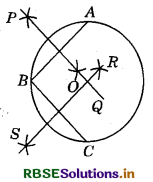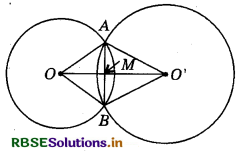RBSE Solutions for Class 9 Maths Chapter 10 Circles Ex 10.3
Rajasthan Board RBSE Solutions for Class 9 Maths Chapter 10 Circles Ex 10.3 Textbook Exercise Questions and Answers.
Rajasthan Board RBSE Solutions for Class 9 Maths in Hindi Medium & English Medium are part of RBSE Solutions for Class 9. Students can also read RBSE Class 9 Maths Important Questions for exam preparation. Students can also go through RBSE Class 9 Maths Notes to understand and remember the concepts easily. Practicing the class 9 math chapter 13 hindi medium textbook questions will help students analyse their level of preparation.
RBSE Class 9 Maths Solutions Chapter 10 Circles Ex 10.3
Question 1.
Draw different pairs of circles. How many points does each pair have in common? What is the maximum number of common points?
Answer:
The different pairs of circles are:

Clearly, these pairs may have 0 or 1 or 2 points in common.
Thus, a pair of circles cannot intersect each other at more than two points.
Question 2.
Suppose you are given a circle. Give a construction to find its centre.
Answer:
Steps of construction :

- Take 3 points A, B and C on the circle.
- Join AB and BC.
- Draw PQ and RS, respectively the perpendicular bisectors, of AB and BC, which intersect each other at O. Then, 0 is the centre of the circle.

Question 3.
If two circles intersect at two points, prove that their centres lie on the perpendicular bisector of the common chord.
Answer:
Given : Two circles, with centres O and O' intersect at two points A and B so that AB is the common chord of the two circles and 00' is the line segment joining the centres of the two circles. Let 00' intersect AB at M.

To prove: 00' is the perpendicular bisector of AB.
Construction: Draw line segments OA, OB, O'A and O'B.
Proof : In ∆s OAO' and OBO’, we have :
OA = OB (Radii of the same circle)
O'A = O'B (Radii of the same circle)
and, OO' = OO' (Common)
∴ By SSS criterion of congruence, we have :
∆OAO' = ∆OBO'
So, ∠AOO' = ∠BOO' (CPCT)
or ∠AOM = ∠BOM ...........(1) (∵ ∠AOO' = ∠AOM and ∠BOO = ∠BOM)
In ∆s AOM and BOM, we have :
OA = OB (Radii of the same circle)
∠AOM = ∠BOM [From (1)]
and, OM = OM (Common)
By SAS criterion of congruence, we have :
∆AOM = ∆BOM
So, AM =BM and ∠AMO = ∠BMO
But ∠AMO + ∠BMO = 180°
2∠AMO = 180° or ∠AMO = 90°
Thus, AM =BM and ∠AMO = ∠BMO = 90°.
Hence, OO' is the perpendicular bisector of AB.

- RBSE Solutions for Class 9 Maths Chapter 6 रेखाएँ और कोण Ex 6.3
- RBSE Solutions for Class 9 Maths Chapter 14 सांख्यिकीEx 14.3
- RBSE Solutions for Class 9 Maths Chapter 13 पृष्ठीय क्षेत्रफल एवं आयतन Ex 13.5
- RBSE Solutions for Class 9 Maths Chapter 13 पृष्ठीय क्षेत्रफल एवं आयतन Ex 13.4
- RBSE Solutions for Class 9 Maths Chapter 10 Circles Ex 10.2
- RBSE Solutions for Class 9 Maths Chapter 10 Circles Ex 10.1
- RBSE Solutions for Class 9 Maths Chapter 9 Areas of Parallelograms and Triangles Ex 9.2
- RBSE Solutions for Class 9 Maths Chapter 11 Constructions Ex 11.1
- RBSE Solutions for Class 9 Maths Chapter 9 Areas of Parallelograms and Triangles Ex 9.3
- RBSE Solutions for Class 9 Maths Chapter 11 Constructions Ex 11.2
- RBSE Solutions for Class 9 Maths Chapter 7 Triangles Ex 7.4